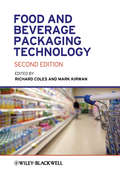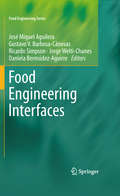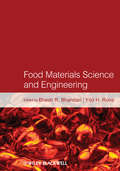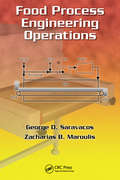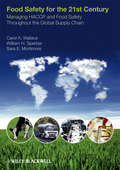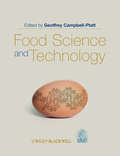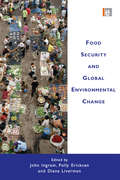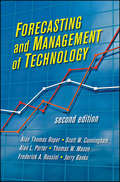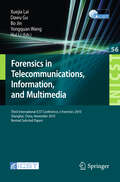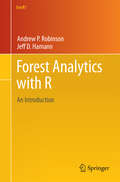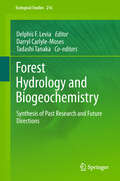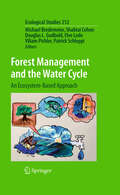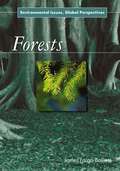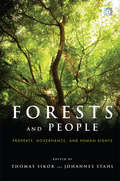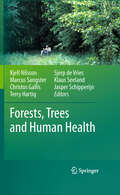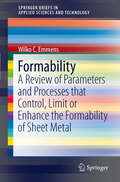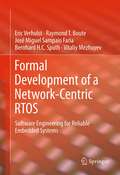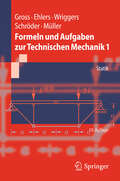- Table View
- List View
Food and Beverage Packaging Technology
by Richard Coles Mark J. KirwanNow in a fully revised and updated second edition, this volume provides a contemporary overview of food processing/packaging technologies. It acquaints the reader with food preservation processes, shelf life and logistical considerations, as well as packaging materials, machines and processes necessary for a wide range of packaging presentations. The new edition addresses environmental and sustainability concerns, and also examines applications of emerging technologies such as RFID and nanotechnology. It is directed at packaging technologists, those involved in the design and development of packaging, users of packaging in food companies and those who specify or purchase packaging. Key Features: An up-to-date and comprehensive handbook on the most important sector of packaging technology Links methods of food preservation to the packaging requirements of the common types of food and the available food packages Covers all the key packaging materials - glass, plastics and paperboard Fully revised second edition now covers sustainability, nanotechnology and RFID
Food Engineering Interfaces (Food Engineering Series)
by José Miguel Aguilera, Ricardo Simpson, Jorge Welti-Chanes, Daniela Bermudez-Aguirre and Gustavo Barbosa-CanovasThe International Conference on Food Engineering is held every four years and draws global participation. ICEF 10 will be held in April 2008 in Chile with the theme of food engineering at interfaces. This will not be a typical proceedings with uneven contributions. Papers will be solicited from each plenary speaker plus two or three invited speakers from each topic and the goal is to publish a book that conveys the interdisciplinary spirit of the meeting as well as covers the topics in depth, creating a strong reference work. The idea is to explore how food engineers have to be prepared in years ahead not only to perform in their normal activities but also to engage in new challenges and opportunities that will make the profession more attractive, responsive, and able to create a larger impact. These challenges and opportunities are within the profession and at interfaces with other areas. A major role of engineers is to incorporate new knowledge into the profession and respond to practical needs. The goal is to explore how food engineers are integrating developments in the basic sciences of physics and chemistry, nutrition, informatics, material sciences, genomics (and other -omics), quality and safety, consumer behavior and gastronomy. Interfaces with the environment, the business sector, regulations and export markets are also important to consider.
Food Materials Science and Engineering
by Bhesh BhandariFood Materials Science and Engineering covers a comprehensive range of topics in relation to food materials, their properties and characterisation techniques, thus offering a new approach to understanding food production and quality control. The opening chapter will define the scope and application of food materials science, explaining the relationship between raw material structure and processing and quality in the final product. Subsequent chapters will examine the structure of food materials and how they relate to quality, sensory perception, processing attributes and nutrient delivery. The authors also address applications of nanotechnology to food and packaging science. Methods of manufacturing food systems with improved shelf-life and quality attributes will be highlighted in the book.
Food Materials Science and Engineering
by Bhesh BhandariFood Materials Science and Engineering covers a comprehensive range of topics in relation to food materials, their properties and characterisation techniques, thus offering a new approach to understanding food production and quality control. The opening chapter will define the scope and application of food materials science, explaining the relationship between raw material structure and processing and quality in the final product. Subsequent chapters will examine the structure of food materials and how they relate to quality, sensory perception, processing attributes and nutrient delivery. The authors also address applications of nanotechnology to food and packaging science. Methods of manufacturing food systems with improved shelf-life and quality attributes will be highlighted in the book.
Food Process Engineering Operations (Contemporary Food Engineering Ser.)
by George D. SaravacosA unique and interdisciplinary field, food processing must meet basic process engineering considerations such as material and energy balances, as well as the more specialized requirements of food acceptance, human nutrition, and food safety. Food engineering, therefore, is a field of major concern to university departments of food science, and chem
Food Safety for the 21st Century: Managing HACCP and Food Safety Throughout the Global Supply Chain
by Carol A. Wallace William H. Sperber Sara E. MortimoreThe HACCP (Hazard Analysis and Critical Control Points) system is still recognised internationally as the most effective way to produce safe food throughout the supply chain, but a HACCP system cannot operate in a vacuum. It requires prerequisite programmes to be in place and it can be highly affected by, or dependent upon, other major considerations such as animal, plant, human and environmental health, food security and food defence. This book: Provides a practical and up-to-date text covering the essentials of food safety management in the global supply chain, giving the reader the knowledge and skills that they need to design, implement and maintain a world-class food safety programme. Builds on existing texts on HACCP and food safety, taking the next step forward in the evolution of HACCP and providing a text that is relevant to all sectors and sizes of food businesses throughout the world. Shares practical food safety experience, allowing development of best-practice approaches. This will allow existing businesses to improve their systems and enable businesses that are new to HACCP and food safety management requirements in both developed and developing countries to build on existing knowledge for more rapid application of world-class food safety systems. Educates practitioners such that they will be able to use their judgement in decision-making and to influence those who make food policy and manage food operations. This book is an essential resource for all scientists and managers in the food industry (manufacturing and foodservice); regulators and educators in the field of food safety; and students of food science and technology.
Food Science and Technology
by Geoffrey Campbell-PlattThis brand new comprehensive text and reference book is designed to cover all the essential elements of food science and technology, including all core aspects of major food science and technology degree programs being taught worldwide. Food Science and Technology, supported by the International Union of Food Science and Technology comprises 21 chapters, carefully written in a user-friendly style by 30 eminent industry experts, teachers and researchers from across the world. All authors are recognised experts in their respective fields, and together represent some of the world’s leading universities and international food science and technology organisations. Expertly drawn together, produced and edited, Food Science and Technology provides the following: Coverage of all the elements of food science and technology degree programs internationally Essential information for all professionals in the food industry worldwide Chapters written by authoritative, internationally respected contributing authors A must-have reference book for libraries in every university, food science and technology research institute, and food company globally Additional resources published on the book's web site: www.wiley.com/go/campbellplatt About IUFoST The International Union of Food Science and Technology (IUFoST) is a country-membership organisation representing some 65 member countries, and around 200,000 food scientists and technologists worldwide. IUFoST is the global voice of food science and technology, dedicated to promoting the sharing of knowledge and good practice in food science and technology internationally. IUFoST organises World Congresses of Food Science and Technology, and has established the International Academy of Food Science and Technology (IAFoST) to which eminent food scientists can be elected by peer review. For further information about IUFoST and its activities, visit: www.iufost.org
Food Security and Global Environmental Change
by John Ingram Polly Ericksen Diana LivermanGlobal environmental change (GEC) represents an immediate and unprecedented threat to the food security of hundreds of millions of people, especially those who depend on small-scale agriculture for their livelihoods. As this book shows, at the same time, agriculture and related activities also contribute to GEC by, for example, intensifying greenhouse gas emissions and altering the land surface. Responses aimed at adapting to GEC may have negative consequences for food security, just as measures taken to increase food security may exacerbate GEC. The authors show that this complex and dynamic relationship between GEC and food security is also influenced by additional factors; food systems are heavily influenced by socioeconomic conditions, which in turn are affected by multiple processes such as macro-level economic policies, political conflicts and other important drivers. The book provides a major, accessible synthesis of the current state of knowledge and thinking on the relationships between GEC and food security. Most other books addressing the subject concentrate on the links between climate change and agricultural production, and do not extend to an analysis of the wider food system which underpins food security; this book addresses the broader issues, based on a novel food system concept and stressing the need for actions at a regional, rather than just an international or local, level. It reviews new thinking which has emerged over the last decade, analyses research methods for stakeholder engagement and for undertaking studies at the regional level, and looks forward by reviewing a number of emerging 'hot topics' in the food security-GEC debate which help set new agendas for the research community at large. Published with Earth System Science Partnership, GECAFS and SCOPE
Food Security and Global Environmental Change
by John Ingram Polly Ericksen Diana LivermanGlobal environmental change (GEC) represents an immediate and unprecedented threat to the food security of hundreds of millions of people, especially those who depend on small-scale agriculture for their livelihoods. As this book shows, at the same time, agriculture and related activities also contribute to GEC by, for example, intensifying greenhouse gas emissions and altering the land surface. Responses aimed at adapting to GEC may have negative consequences for food security, just as measures taken to increase food security may exacerbate GEC. The authors show that this complex and dynamic relationship between GEC and food security is also influenced by additional factors; food systems are heavily influenced by socioeconomic conditions, which in turn are affected by multiple processes such as macro-level economic policies, political conflicts and other important drivers. The book provides a major, accessible synthesis of the current state of knowledge and thinking on the relationships between GEC and food security. Most other books addressing the subject concentrate on the links between climate change and agricultural production, and do not extend to an analysis of the wider food system which underpins food security; this book addresses the broader issues, based on a novel food system concept and stressing the need for actions at a regional, rather than just an international or local, level. It reviews new thinking which has emerged over the last decade, analyses research methods for stakeholder engagement and for undertaking studies at the regional level, and looks forward by reviewing a number of emerging 'hot topics' in the food security-GEC debate which help set new agendas for the research community at large. Published with Earth System Science Partnership, GECAFS and SCOPE
Forecasting and Management of Technology
by Alan L. Porter Scott W. Cunningham Jerry Banks A. Thomas Roper Thomas W. Mason Frederick A. RossiniPublished in 1991, the first edition of Forecasting and Management of Technology was one of the leading handful of books to deal with the topic of forecasting of technology and technology management as this discipline was emerging. The new, revised edition of this book will build on this knowledge in the context of business organizations that now place a greater emphasis on technology to stay on the cutting edge of development. The scope of this edition has broadened to include management of technology content that is relevant to now to executives in organizations while updating and strengthening the technology forecasting and analysis content that the first edition is reputed for. Updated by the original author team, plus new author Scott Cunningham, the book takes into account what the authors see as the innovations to technology management in the last 17 years: the Internet; the greater focus on group decision-making including process management and mechanism design; and desktop software that has transformed the analytical capabilities of technology managers. Included in this book will be 5 case studies from various industries that show how technology management is applied in the real world.
Forecasting and Management of Technology
by Alan L. Porter Scott W. Cunningham Jerry Banks A. Thomas Roper Thomas W. Mason Frederick A. RossiniPublished in 1991, the first edition of Forecasting and Management of Technology was one of the leading handful of books to deal with the topic of forecasting of technology and technology management as this discipline was emerging. The new, revised edition of this book will build on this knowledge in the context of business organizations that now place a greater emphasis on technology to stay on the cutting edge of development. The scope of this edition has broadened to include management of technology content that is relevant to now to executives in organizations while updating and strengthening the technology forecasting and analysis content that the first edition is reputed for. Updated by the original author team, plus new author Scott Cunningham, the book takes into account what the authors see as the innovations to technology management in the last 17 years: the Internet; the greater focus on group decision-making including process management and mechanism design; and desktop software that has transformed the analytical capabilities of technology managers. Included in this book will be 5 case studies from various industries that show how technology management is applied in the real world.
Forensics in Telecommunications, Information and Multimedia: Third International ICST Conference, e-Forensics 2010, Shanghai, China, November 11-12, 2010, Revised Selected Papers (Lecture Notes of the Institute for Computer Sciences, Social Informatics and Telecommunications Engineering #56)
by Xuejia Lai Dawu Gu Bo Jin Yong Wang Hui LiThis book constitutes the thoroughly refereed post-conference proceedings of the Third International ICST Conference on Forensic Applications and Techniques in Telecommunications, Information and Multimedia, E-Forensics 2010, held in Shanghai, China, in November 2010. The 32 revised full papers presented were carefully reviewed and selected from 42 submissions in total. These, along with 5 papers from a collocated workshop of E-Forensics Law, cover a wide range of topics including digital evidence handling, data carving, records tracing, device forensics, data tamper identification, and mobile device locating.
Forest Analytics with R: An Introduction (Use R!)
by Andrew P. Robinson Jeff D. HamannForest Analytics with R combines practical, down-to-earth forestry data analysis and solutions to real forest management challenges with state-of-the-art statistical and data-handling functionality. The authors adopt a problem-driven approach, in which statistical and mathematical tools are introduced in the context of the forestry problem that they can help to resolve. All the tools are introduced in the context of real forestry datasets, which provide compelling examples of practical applications. The modeling challenges covered within the book include imputation and interpolation for spatial data, fitting probability density functions to tree measurement data using maximum likelihood, fitting allometric functions using both linear and non-linear least-squares regression, and fitting growth models using both linear and non-linear mixed-effects modeling. The coverage also includes deploying and using forest growth models written in compiled languages, analysis of natural resources and forestry inventory data, and forest estate planning and optimization using linear programming. The book would be ideal for a one-semester class in forest biometrics or applied statistics for natural resources management. The text assumes no programming background, some introductory statistics, and very basic applied mathematics.
Forest Hydrology and Biogeochemistry: Synthesis of Past Research and Future Directions (Ecological Studies #216)
by Delphis F. Levia, Darryl Carlyle-Moses and Tadashi TanakaThis international rigorously peer-reviewed volume critically synthesizes current knowledge in forest hydrology and biogeochemistry. It is a one-stop comprehensive reference tool for researchers and practitioners in the fields of hydrology, biogeoscience, ecology, forestry, boundary-layer meteorology, and geography. Following an introductory chapter tracing the historical roots of the subject, the book is divided into the following main sections:· Sampling and Novel Approaches· Forest Hydrology and Biogeochemistry by Ecoregion and Forest Type· Hydrologic and Biogeochemical Fluxes from the Canopy to the Phreatic Surface· Hydrologic and Biogeochemical Fluxes in Forest Ecosystems: Effects of Time, Stressors, and HumansThe volume concludes with a final chapter that reflects on the current state of knowledge and identifies some areas in need of further research.
Forest Management and the Water Cycle: An Ecosystem-Based Approach (Ecological Studies #212)
by Michael Bredemeier, Shabtai Cohen, Douglas L. Godbold, Elve Lode, Viliam Pichler and Patrick SchleppiThe protective function of forests for water quality and water-related hazards, as well as adequate water supplies for forest ecosystems in Europe, are potentially at risk due to changing climate and changing land-management practices. Water budgets of forest ecosystems are heavily dependent on climate and forest structure. The latter is determined by the management measures applied in the forestry sector. Various developments of forest management strategies, imposed on a background of changing climate, are considered in assessing the overall future of forest–water interactions in Europe.Synthesizing recent research on the interactions of forest management and the water regime of forests in Europe and beyond, the book makes an important contribution to the ongoing dialogue between scientists dealing with different scales of forest-water interactions. This collaborative endeavour, which covers geographic and climatic gradients from Iceland to Israel and from southern Spain to Estonia and Finland, was made possible through the COST Action "Forest Management and the Water Cycle (FORMAN)", which was launched in 2007 (http://www.forestandwater.eu/). The book will be of particular interest to the research community involved in forest ecosystem research and forest hydrology, as well as landscape ecologists and hydrologists in general. It will also provide reference material for forest practitioners and planners in hydrology and land use.
Forests: Environmental Issues, Global Perspectives (Environmental Issues, Global Perspectives Ser.)
by James Fargo BalliettForests are considered the lungs of the planet, as they consume and store carbon dioxide and produce oxygen. These biomes, defined as ecological communities dominated by long-lived woody vegetation, historically have provided an economic foundation for growing nations, supplying wood for buildings, firewood for fuel, and land for expanding cities and farms. For centuries, industrial nations in Europe and the United States have relied on large tracts of forestland for economic prosperity. The research presented in this book reveals that population pressures are causing considerable environmental distress in even the most remote forest areas. Three detailed case studies are presented. The first provides an assessment of illegal logging deep in South America’s Amazon rain forest, a region closely tied to food and product demands thousands of miles away. The second examines the effect of increased hunting in Central Africa’s Congo forest, which threatens wildlife, especially mammal species with slower reproductive cycles. Finally the third describes encroachment on old-growth tropical forests on the Southern Pacific island of Borneo, which today is better managed thanks to the collective planning and conservation efforts of the governments of Brunei, Indonesia, and Malaysia.
Forests: Environmental Issues, Global Perspectives
by James Fargo BalliettForests are considered the lungs of the planet, as they consume and store carbon dioxide and produce oxygen. These biomes, defined as ecological communities dominated by long-lived woody vegetation, historically have provided an economic foundation for growing nations, supplying wood for buildings, firewood for fuel, and land for expanding cities and farms. For centuries, industrial nations in Europe and the United States have relied on large tracts of forestland for economic prosperity. The research presented in this book reveals that population pressures are causing considerable environmental distress in even the most remote forest areas. Three detailed case studies are presented. The first provides an assessment of illegal logging deep in South America’s Amazon rain forest, a region closely tied to food and product demands thousands of miles away. The second examines the effect of increased hunting in Central Africa’s Congo forest, which threatens wildlife, especially mammal species with slower reproductive cycles. Finally the third describes encroachment on old-growth tropical forests on the Southern Pacific island of Borneo, which today is better managed thanks to the collective planning and conservation efforts of the governments of Brunei, Indonesia, and Malaysia.
Forests and People: Property, Governance, and Human Rights
by Thomas Sikor Johannes StahlA human rights-based agenda has received significant attention in writings on general development policy, but less so in forestry. Forests and People presents a comprehensive analysis of the rights-based agenda in forestry, connecting it with existing work on tenure reform, governance rights and cultural rights. As the editors note in their introduction, the attention to rights in forestry differs from 'rights-based approaches' in international development and other natural resource fields in three critical ways. First, redistribution is a central demand of activists in forestry but not in other fields. Many forest rights activists call for not only the redirection of forest benefits but also the redistribution of forest tenure to redress historical inequalities. Second, the rights agenda in forestry emerges from numerous grassroots initiatives, setting forest-related human rights apart from approaches that derive legitimacy from transnational human rights norms and are driven by international and national organizations. Third, forest rights activists attend to individual as well as peoples' collective rights whereas approaches in other fields tend to emphasize one or the other set of rights. Forests and People is a timely response to the challenges that remain for advocates as new trends and initiatives, such as market-based governance, REDD, and a rush to biofuels, can sometimes seem at odds with the gains from what has been a two decade expansion of forest peoples' rights. It explores the implications of these forces, and generates new insights on forest governance for scholars and provides strategic guidance for activists.
Forests and People: Property, Governance, and Human Rights
by Thomas Sikor Johannes StahlA human rights-based agenda has received significant attention in writings on general development policy, but less so in forestry. Forests and People presents a comprehensive analysis of the rights-based agenda in forestry, connecting it with existing work on tenure reform, governance rights and cultural rights. As the editors note in their introduction, the attention to rights in forestry differs from 'rights-based approaches' in international development and other natural resource fields in three critical ways. First, redistribution is a central demand of activists in forestry but not in other fields. Many forest rights activists call for not only the redirection of forest benefits but also the redistribution of forest tenure to redress historical inequalities. Second, the rights agenda in forestry emerges from numerous grassroots initiatives, setting forest-related human rights apart from approaches that derive legitimacy from transnational human rights norms and are driven by international and national organizations. Third, forest rights activists attend to individual as well as peoples' collective rights whereas approaches in other fields tend to emphasize one or the other set of rights. Forests and People is a timely response to the challenges that remain for advocates as new trends and initiatives, such as market-based governance, REDD, and a rush to biofuels, can sometimes seem at odds with the gains from what has been a two decade expansion of forest peoples' rights. It explores the implications of these forces, and generates new insights on forest governance for scholars and provides strategic guidance for activists.
Forests, Trees and Human Health
by Kjell Nilsson, Marcus Sangster, Christos Gallis, Terry Hartig, Sjerp de Vries, Klaus Seeland and Jasper SchipperijnThe link between modern lifestyles and increasing levels of chronic heart disease, obesity, stress and poor mental health is a concern across the world. The cost of dealing with these conditions places a large burden on national public health budgets so that policymakers are increasingly looking at prevention as a cost-effective alternative to medical treatment. Attention is turning towards interactions between the environment and lifestyles. Exploring the relationships between health, natural environments in general, and forests in particular, this groundbreaking book is the outcome of the European Union’s COST Action E39 ‘Forests, Trees and Human Health and Wellbeing’, and draws together work carried out over four years by scientists from 25 countries working in the fields of forestry, health, environment and social sciences. While the focus is primarily on health priorities defined within Europe, this volume explicitly draws also on research from North America.
Formability: A Review of Parameters and Processes that Control, Limit or Enhance the Formability of Sheet Metal (SpringerBriefs in Applied Sciences and Technology)
by Wilko C. Emmens- Overview of materials and treatment aspects of manufacturability of sheet metal - Written by an industrial expert turned scientist - Concentrates on the formability of sheet metal, one of the fundamental form material is used in metalworking
Formal Development of a Network-Centric RTOS: Software Engineering for Reliable Embedded Systems
by Eric Verhulst Raymond T. Boute José Miguel Faria Bernhard H.C. Sputh Vitaliy MezhuyevMany systems, devices and appliances used routinely in everyday life, ranging from cell phones to cars, contain significant amounts of software that is not directly visible to the user and is therefore called "embedded". For coordinating the various software components and allowing them to communicate with each other, support software is needed, called an operating system (OS). Because embedded software must function in real time (RT), a RTOS is needed. This book describes a formally developed, network-centric Real-Time Operating System, OpenComRTOS. One of the first in its kind, OpenComRTOS was originally developed to verify the usefulness of formal methods in the context of embedded software engineering. Using the formal methods described in this book produces results that are more reliable while delivering higher performance. The result is a unique real-time concurrent programming system that supports heterogeneous systems with just 5 Kbytes/node. It is compatible with safety related engineering standards, such as IEC61508.
Formeln und Aufgaben zur Technischen Mechanik 1: Statik (Springer-Lehrbuch)
by Dietmar Gross Wolfgang Ehlers Peter Wriggers Jörg Schröder Ralf MüllerDie Aufgabensammlung zum Band „Technische Mechanik 1 (Statik)“ enthält die wichtigsten Formeln und mehr als 140 didaktisch gut aufgebaute, vollständig gelöste Aufgaben. Besonderer Wert wird auf das Finden des Lösungswegs und das Erstellen der Grundgleichungen gelegt. Folgende Themen werden in den Aufgaben behandelt: Gleichgewicht; Schwerpunkt; Lagerreaktionen; Fachwerke; Balken, Rahmen, Bogen; Seile; Arbeitsbegriff in der Statik; Haftung und Reibung; Flächenträgheitsmomente. Die 10. Auflage präsentiert sich in einem neuen, zweifarbigen Layout.
Formeln und Aufgaben zur Technischen Mechanik 2: Elastostatik, Hydrostatik (Springer-Lehrbuch)
by Dietmar Gross Wolfgang Ehlers Peter Wriggers Jörg Schröder Ralf MüllerDas Aufgabenbuch zur Technischen Mechanik 2 (Elastostatik, Hydrostatik) enthält die wichtigsten Formeln und etwa 150 vollständig gelöste Aufgaben. Weil der Weg zum erfolgreichen Studium der Technischen Mechanik über das selbständige Lösen von Aufgaben führt, legen die Autoren besonderen Wert darauf, dass Leser befähigt werden Lösungswege zu finden und Grundgleichungen zu erstellen. In dem Band werden folgende Themen behandelt: Spannung und Verzerrung, Zug und Druck, Biegung, Torsion, der Arbeitsbegriff in der Elastostatik, Stabilität, Hydrostatik.
Formeln und Tabellen zur Technischen Mechanik
by Alfred BögeIm Lehr- und Lernsystem Technische Mechanik unterstützt die Formelsammlung das selbstständige Lernen bei der Hausarbeit genauso wie bei der Lösung von Klausuraufgaben. Die Formeln und Tabellen liefern die physikalischen, mathematischen und technischen Daten zum Lösen der Aufgaben. Die aktuelle Auflage wurde an die 29. Auflage des Lehrbuchs angepasst.
